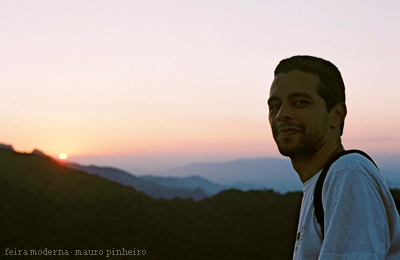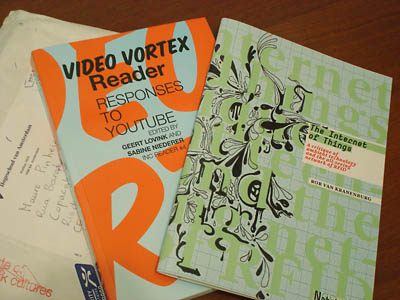Blog
sábado, 7 de março de 2009
Twitter, commented by Evan Williams
An interesting talk at TED, from Evan Williams, one of the minds responsible for Blogger and Twitter.
The talk is about Twitter – how it started, how it evolved, how people created new ways for using it. To me the most interesting part of this talk is exactly when EV talks about how people are making part of the creative process, in a way he and his team couldn’t anticipate. Twitter is a fine example of how a product can really evolve when it’s totally opened for development, not only by making an API available to other developers, but by paying attention on how people use the product. Learn from the real user experience, the one that is built in “real world”, by regular people on daily basis.
Twitter is a huge success, like Blogger before it. Congratulations EV, and keep making incredible things for us! :-)
quarta-feira, 4 de março de 2009
3º EBAI – call for papers
O site do 3º EBAI – Encontro Brasileiro de Arquitetura de Informação já está no ar, e a chamada de trabalhos aberta. Participe!
Parabéns pela iniciativa, mais uma vez, Carol e Guilhermo!
—
The call for papers for the 3rd Brazilian Information Architecture Congress just started. Submit your paper!
terça-feira, 24 de fevereiro de 2009
New article on Ambient Intelligence
I just published here an article I wrote last year, and that will also be published as a chapter of a CD-Rom/book, organized by the graduate programs of PUC-Rio, Anhembi-Morumbi and UNESP-Bauru. The CD-Rom/book will be published by Rosari.
The article is a new version of a presentation I’ve made last year at 2nd. EBAI (Encontro Brasileiro de Arquitetura de Informação). It’s about ambient intelligence, and it’s implications to interaction design.
Take a look: Implicações da inteligência ambiental para o design de interação.
terça-feira, 10 de fevereiro de 2009
Feira Moderna: redesign 2009
After 2 years, it was about time to redesign this website. It took me a long time to face this task, but I finally managed to make it. It wasn’t easy, thought. If it wasn’t enough work to design all the pages, when you finally leave Photoshop and get your hands dirty with HTML, CSS and PHP is that you realize how many details you have to take care.
At least this time I could use almost everything I have done in PHP for the previous version – and I even have improved some stuff too! ;-)
Anyway, after a week of hard work, we’re up and running. Although I have tested things here for some time, it’s possible that many bugs have passed unnoticed. To tell the truth, I still have to remake the CSS version for printing. But as long as you don’t want to print any page, I guess you will find everything in it’s place. :-)
If you see something wrong, or if you just want to say what you think about the new version (like it? hate it?), please, use the ‘comments’ and drop me a line! :-)
UPDATE: now with a clean CSS for printing, as I have done previously!
terça-feira, 20 de janeiro de 2009
2009

This post is just to reassure (even to myself) that I’m alive. With much to do on my thesis, I have no time to write here, even when I have things I would like to share with my few readers.
Thanks for passing by, and have a nice 2009! :-)
quarta-feira, 26 de novembro de 2008
A toolkit for user-centered design process
This Generic Work Process diagram is a very interesting and resourceful toolkit, that covers many phases of the design process. It not only displays the different stages of a user-centered design process, but also describes them; each phase has different tasks/methods, with a description, the purpose of using that particular method, and points out some references from which they researched about the method described. As the authors say, it’s an overview of the methods and techniques which can be used throughout the user-centered design process.
The research department (’lectoraat’) at Communication and Multimedia Design at the Rotterdam University of Applied Sciences, with research professor Ingrid Mulder, has worked on this toolkit with a research group on Human Centered ICT. The project was presented by Bas Leurs during a workshop on November 12, 2008, in which various professionals from the field of education (mainly CMD Rotterdam), discussed and mapped the process of human-centered design, and the available methods and tools for the HCI process. (source: Institute of Network Cultures)
It’s very interest to note that the “user test” is a method that appears in each stage of the design process. It’s a common mistake to think about making user tests only when you have your product done, which is nice and important to do, but as it’s also the latest stage of the product development, it’s the most difficult time to make huge changes and correct problems that may arise from the tests. A practice of constantly testing your designs as it evolves is a more interesting approach, and this work process presented here suggests that either.
quarta-feira, 12 de novembro de 2008
More books!

It’s always a joy when new books arrive. These ones arrived from Amsterdam, sent to me by the Institute of Network Cultures. They are The Internet of Things: a critique of ambient technology and the all seeing network of RFID, by Rob van Kranenburg, and Video Vortex Reader: Responses to YouTube, by Geert Lovink and Sabine Niederer (editors).
You can download PDF versions of these books (and many others) on the Institute of Network Cultures’ website.
